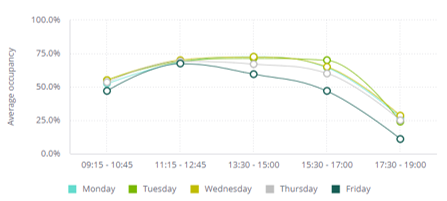The waves of Corona cases are crashing against our society. It’s strongly affecting the organisations that are trying to find a path through this turbulence. One of the most direct effects is workplace occupancy and the use of space. From crowded offices to empty offices. To offices with a few people working between stickers, and hand sanitisers under strict regulations. Times are changing. It’s difficult to keep track of where people are, how they are using these spaces, and to optimise the functionality and use. We want to prevent overcrowding at the office, but also like the office to be a space where people can work safely with each other.
For this reason, many organisations are sharing (vague) statements with recommendations like “Work from home unless you really can’t” which many governments advise (source). Such statements have a large grey area of people doing whatever they prefer anyway. Any well-functioning employee who just likes the social interaction at the office can say: “the walls at home are coming down on me”, making the office crowded nonetheless. While employees who just like to sleep in can say: “I work perfectly at home”, but might actually work quite unproductively.
Work where and when I want
Altogether, the pandemic has brought a new attitude for employees to work where and when they want. Employees want to work remotely on days that fit with them and want to work at the office whenever they please (source). The differences in experiences of remote working between people, strongly contribute to an increase of variation of overcrowded offices and empty offices (source). An effect of this is that we start to see stronger peak days of workplace occupancy at the beginning of the week and almost empty offices on Fridays, like in the project below (performed this year when limited regulations were at play).

Deserted offices and “offices of love”
Next to the new attitude of working, the pandemic by itself also has effects on where and when people can go to work. On the small scale, people more often need to quarantine while on a larger scale, lock-downs force people to stay at home. These factors add up to deserted offices on some days and periods of the year. But as we also experienced, coming out of such lock-downs leads to colleagues wanting to see each other again and feel the freedom to visit the office again (source). Like the summer of love, but then for offices.
Increased volatility
Altogether, the attitude of working where and when I want, and the direct effects of the pandemic, cause higher volatility in occupancy rates. One day the offices are fully packed, the other days they are fully empty. It goes up and down without any structured rhythm, a bit chaotic. These high fluctuations have quite a strong effect on work experience as employees also don’t like the fact that it’s unpredictable. In too crowded offices, people can’t concentrate and might have the fear of contamination (source). While being in too deserted offices, they cause a sense of loneliness and loss of productivity. For facility managers, it is also very difficult to predict such patterns and guide them properly.
Booking systems
One way to guide and understand occupancy is through booking systems. Nevertheless, many of our past studies showed that people don’t always adhere to their booking behaviour. The famous “No shows” (book but don’t show up). Or the “Ghost shows” (don’t book but show up anyway) are messing up the effective- and safe use of workspaces. In one study performed this year, combining a booking system and walk-arounds (when there were limited regulations). The No shows contributed to a whopping 28%. While the Ghost shows contributed to 19% of the occupancy in some buildings (see the picture below).

Workplace observation studies and sensors
To get a grasp of when and where spaces are used to capture a bit of their volatility, one could measure what is really happening. One does this by walk-arounds in workplace observation studies or by using sensor technology that measures occupancy. The workplace observation studies have (one) advantage that they measure how people are using spaces, while the sensors are more feasible to measure over a long period of time.
Conclusions
This period and probably the coming periods will still be relatively unpredictable. We can expect high variations when it comes to occupancy and work experience as a consequence. There are different ways to guide it, and there are different styles of taking control of it and guiding it. Everyone needs to find their own way, but there are many tools to support your personal desires, making your workplace an effective, engaging, and safe space to work in.



